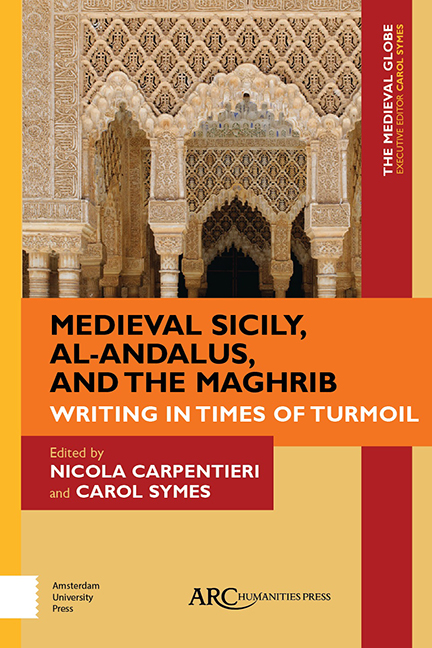Book contents
- Frontmatter
- Contents
- Acknowledgements
- Introduction
- The Indiculus luminosus and the Creation of a Ninth-Century Prophetic Conflict between Christianity and Islam
- Empire and Caliphate in the Life of John of Gorze
- The Writing of Munāẓarāt in Times of Turmoil: Disputations inFatimid Ifrīqiya
- Messaging and Memory: Notes from Medieval Ifrīqiya and Sicily
- “And God Dispersed Their Unity”: Historiographical Patterns in Recounting the End of Muslim Rule in Sicily and al-Andalus
- A Wondrous Past, a Dangerous Present: The Egyptian Temple of Akhmīm and the Martorana Church in Palermo, as Seen through Ibn Jubayr’s Travelogue
- How Does a Moorish Prince Become a Roman Caesar? Fictions and Forgeries, Emperors and Others from the Spanish “Flores” Romances to the Lead Books of Granada
- Index
How Does a Moorish Prince Become a Roman Caesar? Fictions and Forgeries, Emperors and Others from the Spanish “Flores” Romances to the Lead Books of Granada
Published online by Cambridge University Press: 20 November 2020
- Frontmatter
- Contents
- Acknowledgements
- Introduction
- The Indiculus luminosus and the Creation of a Ninth-Century Prophetic Conflict between Christianity and Islam
- Empire and Caliphate in the Life of John of Gorze
- The Writing of Munāẓarāt in Times of Turmoil: Disputations inFatimid Ifrīqiya
- Messaging and Memory: Notes from Medieval Ifrīqiya and Sicily
- “And God Dispersed Their Unity”: Historiographical Patterns in Recounting the End of Muslim Rule in Sicily and al-Andalus
- A Wondrous Past, a Dangerous Present: The Egyptian Temple of Akhmīm and the Martorana Church in Palermo, as Seen through Ibn Jubayr’s Travelogue
- How Does a Moorish Prince Become a Roman Caesar? Fictions and Forgeries, Emperors and Others from the Spanish “Flores” Romances to the Lead Books of Granada
- Index
Summary
WITHIN OUR CONSIDERATION of “writing in times of turmoil,” the romance legend of Prince Flores and his beloved Blancaflor presents a unique set of concerns. As the romance circulated throughout medieval Europe and the Mediterranean, the protagonist and his beloved went by as many names as the vernacular languages in which their story was written and rewritten: Floire and Blancheflor in Old French, Florios and Platziaflora in Byzantine Greek, Florio and Biancifiore in Italian (to list only a few). But across such tellings and retellings, Flores is always a “Moorish” (Muslim) prince of al-Andalus, and his story is set amid the interreligious contact and conflict between Muslims and Christians, both in and beyond the Iberian Peninsula. When the protagonists thus receive their literary baptism as “Flores y Blancalfor,” their translation into a Castilian vernacular stands as a homecoming and prompts us to consider what it means to continually re-write an already told story, and what happens when such re-writing occurs within the very place of turmoil represented in the narrative.
Indeed, the Flores romance was told not once but twice in Castilian, at two very different moments in the history of Muslim– Christian relations in Spain. The earlier version comes to us as part a chronicle contained in a manuscript dated to around 1390, though quite likely based on a thirteenth-century original. Here, the Flores legend finds itself within the Estoria de Espanna, originally composed at the court of Alfonso X “El Sabio” of Castile (r. 1252– 1284), where it is woven into chapters describing the reign and military campaigns of the Asturian king Alfonso I “El Católico” (r. 739– 757). Composed much later, the second version of the Flores romance marks the beginning of printing in Spain. Taking as its abbreviated title The Story of the Two Lovers Flores and Blancaflor (La historia de los dos enamorados Flores y Blancaflor), this text was published in 1512 by the press of Arnao Guillén de Brocar in Alacalá de Henares, where— just a little over a decade before— the influential archbishop and statesman Francisco Jiménez de Cisneros had expanded the studium generale of late thirteenth-century origins into a university that aimed to be Spain's leading centre of humanist education. But despite its academic provenance and certain narrative elements that align with humanist interest in classical culture, this Flores was most likely aimed at a popular readership.
- Type
- Chapter
- Information
- Medieval Sicily, al-Andalus, and the MaghribWriting in Times of Turmoil, pp. 149 - 170Publisher: Amsterdam University PressPrint publication year: 2020



